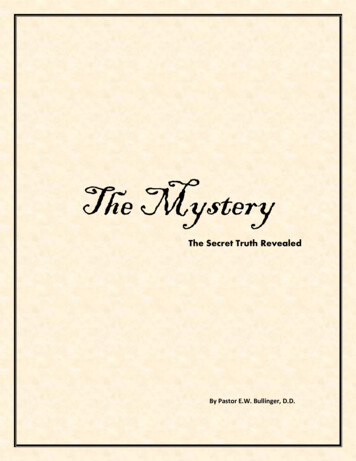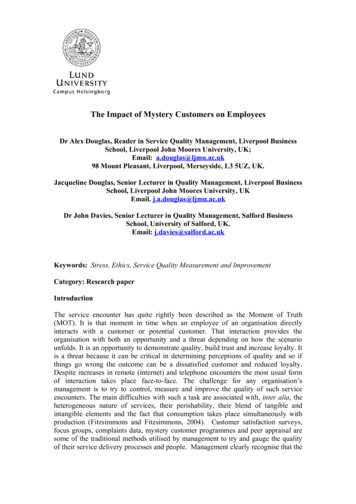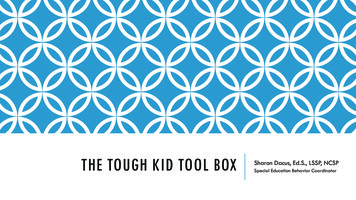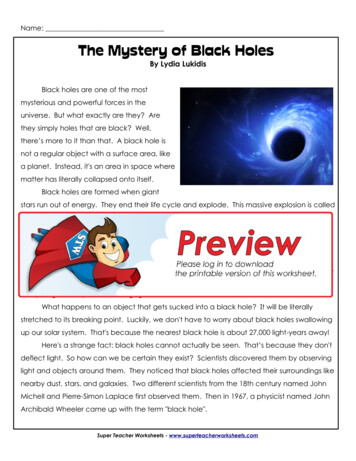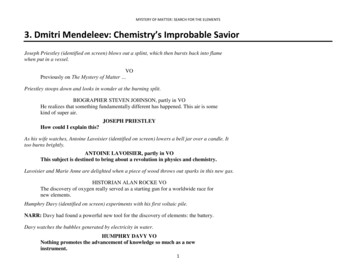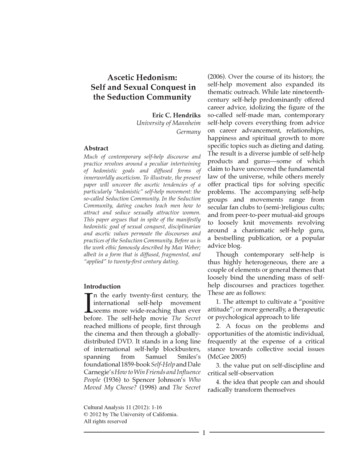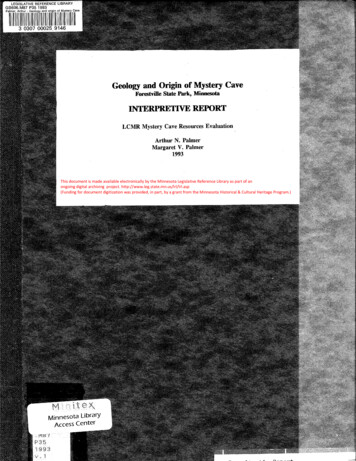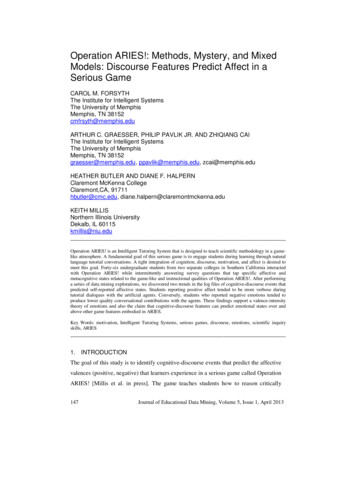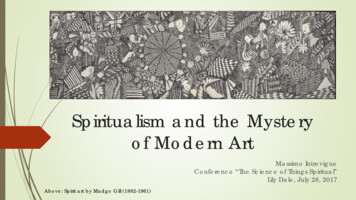
Transcription
Spiritualism and the Mysteryof Modern ArtMassimo IntrovigneConference “The Science of Things Spiritual”Lily Dale, July 28, 2017Above: Spirit art by Madge Gill (1882-1961)
“An Embarrassing Story” “The fact is, theosophy [but the samejudgement is applied to Spiritualism] isembarrassing. If there is one thing youdo not want your hardcore modernistto be, it is a member of an occult cult[ ]. [This] takes art into Dan Brownterritory. No serious student of art historywants to touch it.”Waldemar Januszczak (right)Superstar British art historianThe Sunday Times, 21 February 2010
Six Years Later: Januszczak 2.0 “Only rarely in my time as an art reviewer have I felt as flabbergasted as I was by thewatercolours of [spirit painter] Georgiana Houghton. Her dates had me rubbing myeyes in disbelief. She did this when? Out of nowhere, like an unforeseen comet, acareer has appeared in art that rewrites the whole story.”Waldemar Januszczak“The Woman Who Changes Everything”The Sunday Times, 25 July 2016
Januszczak 2.0 (II) Rediscovering Houghton is “an event oftremendous art-historical significance. Not justbecause Houghton predates Kandinsky andMondrian by half a century, but because hermotivation throws so much clear light on theirmotivation. All the famous pioneers ofabstraction — Kandinsky, Malevich, Mondrian— were spiritualists [ ]. But in all their cases,the occult aspect of their creativity has beenactively suppressed in the canonical story ofmodern art. Potty spiritualist imaginings havenever been allowed to disturb the smoothprogress of progress. On this astonishingevidence, however, the potty spiritualistimaginings were the key ingredient.”
But What Is Spirit Painting? Given that spirit paintings have exerted a decisive influence on modern art,there is a certain confusion on what spirit painting exactly is.We can distinguish at least three different cases:1. Precipitated paintings2. Portraying the spirits during seances3. Painting with hands guided by the spirits
1. Precipitated Paintings The first case is “precipitation” ofworks of art that appeared on canvas(or on paper, or on a slate, left),ostensibly without the use of humanhands, during a Spiritualist seance. Inthis case, the mediums claimed thatthe spirits produced the paintingsdirectly, rather than by guiding thehands of a human artist
David Duguid The first famous medium who wasable to “precipitate” spirit paintingswas Scottish cabinet-maker DavidDuguid (1832-1907). AlthoughDuguid often painted with his handsguided by spirit painters, includingJan Steen (1626-1679) and Jacobvan Ruisdael (1628-1682), his guidesalso produced “direct”(precipitated) works during hisseances, including some thatillustrated his 1876 spirit novel (orhistorical account) Hafed, Prince ofPersia (1876)
Duguid’s “direct” illustrations for Hafed, Prince of Persia
Spirits and Copyright One problem with Duguid was thatthe spirits of Steen and Ruisdaelwere apparently not familiar withcopyright laws. Several “direct”illustrations in the first edition ofHafed were suspiciously similar tothe popular Cassell’s Family Bibleand had to be expunged from thesecond edition
Alternative Explanations For the believers, similarities with the Cassell’s Family Bible, in both the “direct” andthe “guided” spirit paintings of Hafed, were not conclusive evidence of fraud. If onebelieved that the spirit were at work, they could well have worked with material theyfound in the mind of the medium, including reminiscences of the Cassell’s Family Bible
The Campbell Brothers Among the first mediums whospecialized in precipitated paintingswere Lily Dale’s Campbell brothers.Allen Campbell (1833-1919) andCharles Shourds (1863-1926) werenot brothers, but lived and heldseances together
Lincoln Appears Their most famous portraits, such asLincoln’s, were done in public, with theCampbell brothers’ hands nevertouching the canvas
Azur, A. Campbell’s Spirit Guide Statement of six witnesses: “During theentire séance [of June 15, 1898] there waslight enough for us to see everythingperfectly and note the gradual growth ofthe painting on the canvas. Mr. A.Campbell was entranced and Azur, usinghis organism, gave us some very beautifulwords [ ] After some music, additionallights were brought, the curtain withdrawn,and lo! The picture was complete. [ ]While we were admiring it, there came atthe back of the head a six-pointed star,which is now distinctly seen”
The Bang Sisters Not less famous forprecipitated spirit paintingswere the Bang Sisters, Elizabeth(1859-1920), and May (Mary)Elvira (or Eunice) (1862-1917),who kept cottages both at LilyDale and at CampChesterfield, Indiana
The Bang Sisters precipitated (and sometimes spirit-painted) portraits of deceasedpersons. They were repeatedly denounced as frauds, but vigorously defended by asignificant portion of the American Spiritualist community
“The World’s Worst Woman” Unfortunately, spirit paintings becameconnected with the notorious “SwamiLaura Horos,” a.k.a. Ann Odelia Diss Debar(1849-1911?), who claimed to be guidedby the spirits of old masters. Debar endedup in jail in 1901, sentenced to seven-yearimprisonment both for fraud and forimmoral sexual practices in her temple inLondon. Contemporary media labeledDebar as “the world’s worst woman,”which made precipitated spirit paintingsespecially suspect
Rol and Goya And yet witnesses attested that in thepresence of somebody very differentfrom Debar, famous Italian psychicGustavo Adolfo Rol (1903-1994), a manwho never accepted money for hisseances and was famous for hischaritable activities, “brushed moved bythemselves” to paint, or previouslycontrolled white sheets of paperdisplayed works signed by Goya (left),Braque, or Kandinsky – although Rol wasnot sure of what part of their “intelligentspirit” had produced the artworks
Madame Blavatsky, Spirit Painter At the time of the Campbells, or before,none other than Madame Helena Blavatsky(1831-1891), in the early phase of hercareer, was also busy precipitating spiritpaintings. In his definitive 2001 study, JohnPatrick Deveney claimed that herproductions were “in the dozens” They included a portrait made in 1875 of themysterious John King (left) – who, Blavatskylater claimed, was one and the same withTheosophy’s Master Hilarion –
Blavatsky: The First Theosophical Painter? and another, of 1877, of one“Tiruvalla Yogi: from “Ghost Land or theLand of the Living Brotherhood” (right).Although most of these works were“precipitated,” they may imply thatthe first of a long list of Theosophicalpainters was none other thanMadame Blavatsky herself
While We Are at Blavatsky Theosophical Masters are not spirits but century-old human beings living in Tibet or othersecret places. However, Theosophical “Masters painting” was clearly indebted to earlyBlavatsky’s spirit painting For the most famous Master painting experiment, German Victorian painter HermannSchmiechen (1855-1925) was personally selected by Master Morya. In a letter received byMadame Blavatsky, now at the Winterthur Library in Winterthur, Delaware, Morya wrote:“Say to S.[chmiechen] that he will be helped – I myself will guide his hands with brush forK[oot Hoomi]’s portrait”
Laura Holloway Morya also wrote: “Take her with you toSchmiechen and tell her to see.” From thecontext of the letter, it was clear that theunnamed “her” was Laura Holloway (18481930), a colorful American author, Spiritualistmedium, feminist lecturer, and Theosophist
Cigarettes and Masters In1912, Holloway would tell the story of how sheattended with several other Theosophists,including Blavatsky, a session in Schmiechen’sstudio. Holloway (right) was not a smoker, butBlavatsky insisted she smoke a cigarette(perhaps containing more than tobacco?),which put her in the right state to influenceSchmiechen’s mind
Painting the Masters If we trust Holloway’s later recollections,Schmiechen painted Koot Hoomi (left) first.She saw the Master “standing near MrSchmiechen” and heard Blavatsky correctingSchmiechen when she believed the painterdeviated from Koot Hoomi’s likelihood, even if“she sat where she could not see the easel,nor know what was on it”
Blavatsky and the Portraits Holloway reported that Schmiechen thenwent on to portray Master Morya (right),and this portrait was also approved byBlavatsky. According to Blavatsky, a chainwas set in motion whereby she received theimages of the Masters and transmitted themtelepathically to Holloway, who in turntransmitted them to Schmiechen’s mind,while the painter’s hands were guided bythe Masters. The similarities with spiritpaintings are obvious
2. Portraying Spirits During Seances In the heydays of Spiritualism, itbecame very common formediums to sketch portraits ofspirits who they claimed werepresent during the seances. VictorHugo (1802-1885) was a betterwriter than he was a painter, andthe spirit painting he producedduring seances held at his homeare hard to decipher. Othermediums produced better results
A Dynamic Couple Those who sought portraits of the deceasedloved ones in the United States fueled aflourishing Spiritualist market. Prominent therewas the couple of Wella Percy (1833-1900?)and Lizzie Pet Anderson (1839?-1896),partners in life and Spiritualism, although theydivorced in 1875
Portraits from Atlantis The Andersons did more than paint deceased spouses and children for wealthy clients.They channeled and painted masters of wisdom such as Confucius, the legendaryMasonic ancestor Hiram Habiff, and members of “a band of Old Atlantis”
A Continuing Practice Spirit portraits emerging during seancesrarely became part of mainline art.However, the moving practice continuesto this day. Says Coral Ryder, a wellknown British medium: “I do not see thespirits that I draw, my hand is guided, Itherefore do not know how close alikeness I have created unless shown apicture for comparison” (above). LilyDale’s Susan Barnes regularly offerssimilar demonstrations of spirit art (below)
Some Additional Spirit Artists123 There are several hundredspirit painters in this categorytoday. In addition to CoralRyder and Susan Barnes,renowned for the quality oftheir paintings are Ann BridgeDavies in Britain (1),Francesca Ferraro in Canada(2), and Angelique vanBezouwen in the Netherlands(3)
Auragraphs Close to the second category of spiritpaintings are auragraphs, whichrepresent a person’s past, present,and potential as seen by a mediumor clairvoyant. The name wascoined, and the techniquedeveloped, by British medium HaroldSharp (1890-1980) with the help of hisspirit guide, an Austrian monk calledBrother Peter
Contemporary Auragraphs Contemporary spirit artists,such as Susan Barnes,continue to produceauragraphs
Spirit Photography Spirit photography for Spiritualists is notart but an apologetic way to strengthentheir claims. There were and are,however, artistic photographers that areinspired by Spiritualism in their work. Oneclassical example is Czechphotographer František Drtikol (18831961). A contemporary case is Americanphotographer Shannon Taggart, whoalso produced some of the moreimpressive photographs internationally ofcontemporary seances and mediums(right)
3. Hands Guided by Spirits Spirits often guide the medium’shands in our category no. 2 aswell, but the difference with ourthird category is that here,rather than portraits of the spiritsthemselves, different works ofart are produced. Somedistinguish between workscreated in a trance (normallyvery rapidly), a semi-trance(Sister Gertrude Morgan, 19001980, left), or in fullconsciousness
Brazilian Trance Art Within Brazilian Spiritualism, trance painters often channel famous painters and sculptors, andproduce works in their style at surprising speed. José Medrado, of the Cidade da Luz, channels,inter alia, Renoir and Degas
Luiz Antônio Gasparetto As famous as Medrado in Brazil is L.A. Gasparetto, who paints and sculpts with his handsguided by Degas, Botticelli, Modigliani, and many other famous artists
Spirit Architecture Brazilian mediums produce spirit sculpturesin addition to spirit paintings. Spiritarchitecture also exists. Iulia Hasdeu (18691888), a young Romanian poet who haddied at age 18, revealed throughmediums to her famous father, philologistBoian P. Hasdeu (1838-1907), thearchitectural plans for her grave inBucharest and the famous “CastleHasdeu” in Câmpina
Maffei and Rosazza Another example of spirit architectureis the Italian village of Rosazza, nearBiella, built between 1880 and 1899for Italian senator and Freemason,Federico Rosazza (1813-1899), bypainter Giuseppe Maffei (1821-1901). Itwas based on plans he received fromthe spirits of Augustine of Hippo (354430), who was never an architect in hislife, and an unnamed man fromVolterra, Tuscany, who, not surprisingly,recommended to introduce elementsfrom his home city
Outsider Art? Degas is crucial for the history of art, Degas “as channeled by Medrado (or Gasparetto)” forthe art historian is just a curiosity. Other artists who claimed to work with their hands guidedby the spirits, however, produced highly original paintings. Initially, they were studied onlyunder the category of “outsider art” or “art brut,” which also includes work by street artistsand psychiatric patients. Sometimes, spirit artists were psychiatric patients, such as the Swissmedium Hélène Smith (Catherine-Elise Müller, 1861-1929), who painted inter alia visions ofthe Planet Mars and was studied by psychiatrist Théodore Flournoy (1854-1920)
Madge Gill However, “outsider art” is a contested category.Critics also tend to slowly recognize “outsider” artistsas part of “mainline” art history, not to mention thehigh prices their works command at auctions. This isthe case of British artist Madge Gill (1882-1961) who,with hands guided by the spirit Myrninerest (MyInner Rest), created thousands of postcard-sizeornate drawings, and some huge works on calico
Augustin Lesage Outsider art specialists also hail Augustin Lesage (1876-1954), a French coal miner, as aleading Spiritualist painter, “abandoning himself completely to the directing hands of hisspirit guides in a euphoric state” (D. Wojcik)
Raphael Lonné France produced a number ofspirit artists included in thecategory of “outsider art”, fromVictorien Sardou (1831-1908) –who was certainly part of themainline as a playwright – to LaurePigeon (1882-1965). A notablespirit-outsider artist was postmanRaphaël Lonné (1910-1989)
Anna Zemánková An example of the perils and ambiguities of the category of outsider art, as applied toartists guided by spirits, is Czech painter Anna Zemánková (1908-1986). As her workcommand increasingly significant prices, merchants try to downplay her Spiritualist side,although she maintained that her works “painted themselves,” as the spirits guided her
Outsider Spirit Art in the Netherlands At the other extreme (littlestudied spirit artists, with almostno market), Utrecht’s foundationHet Johan Borgman Fondsperforms a remarkable work inpreserving paintings by lesserknown Dutch spirit artists, someof them artistically interesting,such as Jan Huibreght Verwaal(1889-?)
Trance Contacts with the Aliens A parallel genre with respect to spirit art comes from trance contacts with the aliens.They were part and parcel, for example, of the work of another leading Americanoutsider artist, “Prophet” Royal Robertson (1936-1997)
Three Important British Artists In Britain, however, art historians –with a little help from scholars ofWestern esotericism such as MarcoPasi – started noticing recently thatsome spirit-guided artists played animportant role in the birth ofEuropean modern art. The 2007 Ph.D.dissertation at Yale by RachelOberter, “Spiritualism and the VisualImagination in Victorian Britain,”singled out Georgiana Houghton andAnna Mary Howitt-Watts (1824-1884,left). Subsequent exhibitions includedin this mainstreaming process Ethel LeRossignol (1873-1970)
Le Rossignol’s Fantastic World Howitt-Watts’s (or her spirits’) promisingcareer was cut short by mental illness.Ethel Le Rossignol painted only 44works and always insisted their realauthor was the spirit “J.P.F.” Theirmeaning was explained in her largeformat self-published 1933 book, AGoodly Company. Her fantastic,idiosyncratic style confined her in anartistic niche
A.M.T. Pery Alice Mary Theodosia Pery (18331906), a member of a prominentBritish aristocratic family, neversigned her works but was known to,and influential on, GeorgianaHoughton (and possibly MadgeGill). She claimed that spirits quicklyproduced “lines, oval, circles, andother curved lines” through herhands, and she then filled theempty spaces with her own artisticskills
Georgiana Houghton Georgiana Houghton (1814-1884) was a medium who claimed that, when paintings, herhands were fully controlled by her guides, including an otherwise unknown “deaf anddumb” deceased painter called Henry Lenny and the great Correggio (1489-1534). Herself-financed show in London in 1871 did attract notice, although later she was forgotten
The Eye of God Houghton insisted that her The Eye of God (ca. 1862) was actually painted byCorreggio. He had very much changed his style in the spirit world
Did She Invent Abstract Art? Although it is amusing to hear a (former?) nemesis of spiritualist-esoteric art such asJanuszczak proclaiming that Houghton invented abstract art before Kandinsky, and evenaction painting before Pollock, all this should perhaps not be exaggerated. Paintings suchas The Portrait of the Lord Jesus Christ (1862) actually combine traditional Christian andSpiritualist imagery with surprisingly modern combinations of lines and colors
Hilma af Klint (1862-1944) Oberter and Pasi have noticed thesimilarity between the careers, andlate recognition of Houghton andSwedish painter Hilma af Klint The role of af Klint as anotherpioneer of abstract art is nowincreasingly recognized. Af Klintwas instructed by spirit guides,although how exactly they guidedher work is a matter of debate. Shewas also a member of theTheosophical Society
Kandinsky and Spiritualism As Pasi noted, perhaps we should not really dateback abstract art from Wassily Kandinsky (18661944) to af Klint or Houghton, because they did notoffer a theory of abstract But what about Kandinsky himself? He did refer toSpiritualism in his notebooks, and performedparapsychological experiments, including psychiclifting of tables and telepathic communicationsfrom Munich with friends in Russia. He haileddefenders of Spiritualism such as German scientistJohann Karl Friedrich Zöllner (1834-1882) as bravemen maligned by the prevailing academicmaterialism
Kandinsky, Psychic Artist? The influence of Theosophy on Kandinsky(and on a great deal of other modern artluminaries, including Mondrian, LawrenHarris, Malevich, and Giacomo Balla, tomention only a few) is now generallyacknowledged. Unlike Mondrian andHarris, Kandinsky was not a card-carryingmember of the Theosophical Society. Norwas he a spirit artist. However, he attendedlectures by Rudolf Steiner (1861-1925) and,when the latter saw his paintings, he asked:“He can do things and he knows things. Ishe clairvoyant?”
František Kupka,Medium It would be easy to present a laundry list ofmodern artists interested in Spiritualism.Futurists were influenced by spiritphotographs. And it is perhaps more than acuriosity than Czech painter František Kupka(1871-1957), who went from the Theosophyinspired The Way of Silence(1900-1903,above) to the abstract Amorpha (1912,below), started gaining his life as a Spiritualistmedium
Čiurlionis and Spiritualism Kupka is a key link in the passage fromsymbolism (although this is now acontested category) to abstract art.Another is Lithuanian painter andcomposer Mikalojus KonstantinasČiurlionis (1875-1911: Prelude-Angel,1909, right). He also attended Spiritualistseances in the meetings of the protoTheosophical group in Warsaw led by hismentor, Kazimierz Stabrowski (1869-1929)
Besant, Leadbeater, and Count Prozor Although their influence should not be exaggerated, the fathers of abstract art weresomewhat influenced by Thought Forms by Theosophical leaders Annie Besant andCharles Webster Leadbeater (1905) and by Leadbeater’s Man Visible and Invisible(1902).The latter volume’s illustrations had been clairvoyantly produced by theLithuanian Theosophist Count Maurycy Prozor (1849-1928), and both books included theartistic results of psychics “seeing” emotions and feelings, which again had somesimilarities with spirit art
In Conclusion In conclusion, we can perhaps agree withJanuszczak that Houghton (right), and af Klint,and others, not only, in their own way,anticipated Kandinsky and Mondrian but alsohelped critics notice how Spiritualism,Theosophy, what some call “occulture,” andthe occult milieu in general. were important totheir understanding of modern art – althoughangry reactions to the current Guggenheimexhibition of the Rosicrucians (one New YorkTimes critic called their art “tasteless,”“nauseating” and “sordid”) show that not allhave been persuaded
A Role for the Spirits For scholars of Western esotericism, Spiritualists caught “in the air,” before others, ideaswhose time was coming. For believers, perhaps, the spirits presided at the transitiontowards a different art, more attuned to modern timesAbove: Hilma af Klint
For more information: maxintrovigne@gmail.com
Theosophical Masters are not spirits but century-old human beings living in Tibet or other secret places. However, Theosophical “Masters painting” was clearly indebted to early Blavatsky’s spirit painting For the most famous Mas

